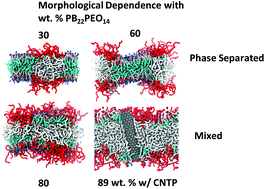Decoupling copolymer, lipid and carbon nanotube interactions in hybrid, biomimetic vesicles†
Abstract
Bilayer vesicles that mimic a real biological cell can be tailored to carry out a specific function by manipulating the molecular composition of the amphiphiles. These bio-inspired and bio-mimetic structures are increasingly being employed for a number of applications from drug delivery to water purification and beyond. Complex hybrid bilayers are the key building blocks for fully synthetic vesicles that can mimic biological cell membranes, which often contain a wide variety of molecular species. While the assembly and morpholgy of pure phospholid bilayer vesicles is well understood, the functionality and structure dramaticlly changes when copolymer and/or carbon nanotube porins (CNTP) are added. The aim of this study is to understand how the collective molecular interactions within hybrid vesicles affect their nanoscale structure and properties. In situ small and wide angle X-ray scattering (SAXS/WAXS) and molecular dynamics simulations (MD) are used to investigate the morphological effect of molecular interactions between polybutadiene polyethylene oxide, lipids and carbon nanotubes (CNT) within the hybrid vesicle bilayer. Within the lipid/copolymer system, the hybrid bilayer morphology transitions from phase separated lipid and compressed copolymer at low copolymer loadings to a mixed bilayer where opposing lipids are mostly separated from the inner region. This transition begins between 60 wt% and 70 wt%, with full homogenization observed by 80 wt% copolymer. The incorporation of CNT into the hybrid vesicles increases the bilayer thickness and enhances the bilayer symmetry. Analysis of the WAXS and MD indicate that the CNT–dioleoyl interactions are much stronger than the CNT–polybutadiene.



 Please wait while we load your content...
Please wait while we load your content...